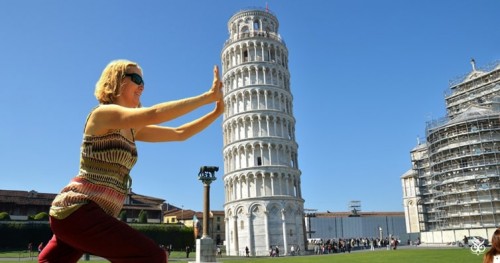Most of us know the Campanile by its more popular name: the leaning Tower of Pisa. Although it is considered an exceptional example of Romanesque architecture, the 187-foot-tall Tower of Pisa is famous all over the world mainly because it leans.
For many years, people believed that the tower's designer intended for it to lean. As it turns out, though, the tower's lean is an accident caused by poor planning.
The Tower of Pisa is made of approximately 16,000 tons of limestone, lime mortar, and marble. Unfortunately, it was constructed on a riverbed of sand and clay that's not strong enough to support a building so tall and heavy.
Construction on the tower began in 1173. Because Pisa became involved in several wars, the tower wasn't completed until 1350. Would you believe that the long construction time probably saved the tower from falling over, though?
Only a few years after construction started, people could see that the first three floors of the tower were already leaning. As the next three floors were added, builders purposefully built them with one side higher than the other to try to correct the lean. This resulted in the tower leaning in the opposite direction. It also means that the tower is actually curved!
Because the ground under the tower consists of unstable sand and clay, the growing building would compress the layers. As the ground was compressed, it would sink more in some areas than in others.
Fortunately for the people of Pisa, the long delays during construction gave the structure time to settle and the ground to become compacted. This made the foundation stronger over time and is the main reason the tower never fell over.
For hundreds of years, the tower was indeed falling. It would lean one more inch about every 20 years. Eventually, in 1990, it was closed to the public for fear that a large group of people at the top would weigh enough to make it topple over.
From 1990-2001, engineers from around the world helped to stabilize the tower. After several unsuccessful attempts at a solution, engineers finally came up with a plan that worked. They slowly removed ground from underneath the high side of the tower.
When they had finished, the tower had been straightened by nearly 16 inches, returning it to the position it held in about 1838. Barring a major catastrophe, such as an earthquake, engineers believe the tower is safe for another 300 years now.
Today, the leaning Tower of Pisa is once again open to visitors. It currently leans at an angle of approximately 3.99 degrees. This means the top is almost 13 feet from where it should be if the tower were perfectly straight.
And in case you're wondering why they didn't go ahead and straighten the tower completely, it's because the people of Pisa wouldn't hear of it. The leaning Tower of Pisa is a major tourist attraction that just wouldn't be the same if it weren't leaning!

At the heart of the city of Pisa, Italy, lies the Piazza del Duomo — the Cathedral Square — which is famous for its beautiful medieval art. Also called the Piazza dei Miracoli — the Square of Miracles — it is home to the city's Cathedral (Duomo) and its freestanding bell tower — called the Campanile.




